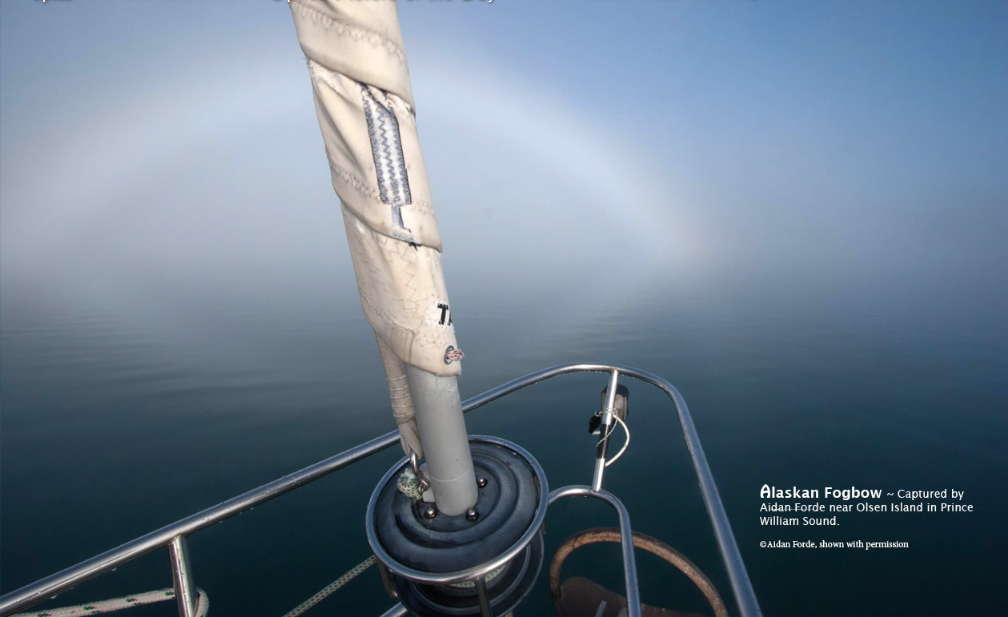Alaskan Fogbow - OPOD
Alaskan Fogbow: An Enchanting Atmospheric Phenomenon
Have you ever heard of an Alaskan Fogbow? This captivating atmospheric phenomenon occurs when cold air hovers over slightly warmer water, creating a blanket of fog composed of tiny droplets. These droplets have a mean diameter of just a few microns, making the fog semi-opaque. Interestingly, despite being farther apart from each other than Earth and its Moon, these droplets still manage to create mesmerizing optical effects. In this article, we will delve into the science behind Alaskan Fogbows and explore their unique characteristics.
Understanding the Formation of Alaskan Fogbows
Sunlight plays a crucial role in the formation of rainbows, and the same principle applies to Fogbows. When sunlight interacts with the tiny water droplets suspended in the fog, it follows specific paths that result in color-making refractions. As the light enters and exits a single droplet, it undergoes a single reflection inside. However, due to the small size of the droplets, diffraction occurs, causing the waves to overlap and broaden the colors present in the bow.
The Broad Spectrum of Colors in Alaskan Fogbows
Unlike traditional rainbows that display a distinct sequence of colors, Alaskan Fogbows exhibit a broader spectrum. The diffraction caused by the small droplets allows for the colors to blend and overlap, resulting in a more ethereal and hazy appearance. This unique characteristic sets Alaskan Fogbows apart from their more vibrant and well-defined counterparts.
The Mystical Allure of Alaskan Fogbows
Alaskan Fogbows possess a mystical allure that captivates all who are fortunate enough to witness them. The interplay between the fog's semi-opaque nature and the diffraction of light creates a breathtaking display that seems to defy logic. As the sunlight filters through the fog, the colors blend and merge, forming a soft and enchanting arc in the sky. The ethereal quality of Alaskan Fogbows adds to their allure, leaving observers in awe of the natural wonders that can be found in the world around us.
Capturing the Beauty of Alaskan Fogbows
Photographing Alaskan Fogbows is no easy feat, as their subtle hues and elusive nature make them a challenge to capture on camera. However, skilled photographers have managed to freeze these ephemeral moments, allowing us to marvel at the beauty of Alaskan Fogbows long after they have dissipated. Aidan Forde, a talented photographer, was fortunate enough to capture an Alaskan Fogbow near Olsen Island in Prince William Sound. His stunning photograph serves as a testament to the captivating nature of this atmospheric phenomenon.
Appreciating Nature's Artistry
Alaskan Fogbows remind us of the incredible artistry present in the natural world. These transient displays of light and color serve as a reminder of the beauty that can be found in even the most ordinary of atmospheric conditions. By taking a moment to appreciate the delicate interplay between light, water droplets, and fog, we gain a deeper understanding of the intricate mechanisms that shape our environment.
Conclusion
Alaskan Fogbows are a mesmerizing atmospheric phenomenon that showcases the beauty and complexity of nature. The interplay between sunlight, fog, and tiny water droplets creates a unique optical effect that broadens the spectrum of colors displayed. Witnessing an Alaskan Fogbow is a truly enchanting experience, as it reminds us of the wonders that can be found in the world around us. So, next time you find yourself in Alaska on a foggy day, keep your eyes peeled for this ethereal display of nature's artistry.

Alaskan Fogbow ~ Captured by
Aidan Forde near Olsen Island in Prince
William Sound.
Aidan Forde, shown with permission

Cold air over slightly warmer water. The stuff of fog. Fog of droplets of mean
diameter just a few micron.
Semi-opaque, even though relative to the drops' diameters they are farther apart from each other then Earth and its Moon.
Sunlight follows the paths that make rainbows. Colour making refractions at entrance and exit a single reflection inside the drop. But a drop small enough that diffraction spreads the waves to over-lap the colours and broaden the
bow.
Note: this article has been automatically converted from the old site and may not appear as intended. You can find the original article here.
Reference Atmospheric Optics
If you use any of the definitions, information, or data presented on Atmospheric Optics, please copy the link or reference below to properly credit us as the reference source. Thank you!
-
<a href="https://atoptics.co.uk/blog/alaskan-fogbow-opod/">Alaskan Fogbow - OPOD</a>
-
"Alaskan Fogbow - OPOD". Atmospheric Optics. Accessed on April 20, 2024. https://atoptics.co.uk/blog/alaskan-fogbow-opod/.
-
"Alaskan Fogbow - OPOD". Atmospheric Optics, https://atoptics.co.uk/blog/alaskan-fogbow-opod/. Accessed 20 April, 2024
-
Alaskan Fogbow - OPOD. Atmospheric Optics. Retrieved from https://atoptics.co.uk/blog/alaskan-fogbow-opod/.